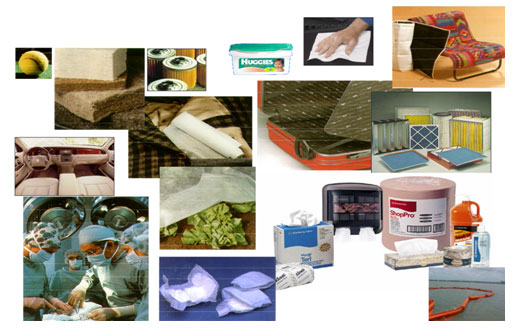Module 1: Overview of Nonwovens |
1.1 Nonwovens: What are they
|
Introduction to nonwovens |
| |
Nonwovens are known as engineered fabrics. They are created with a view to targeted structure and properties by applying a set of scientific principles for a variety of applications. |
| |
Nonwovens are manufactured by high-speed and low-cost processes. As compared to the traditional woven and knitting technology, a larger volume of materials can be produced at a lower cost by using nonwoven technology. |
| |
The manufacturing principles of nonwovens are manifested in a unique way based on the technologies of creation of textiles, papers, and plastics (Figure 1.1), as a result, the structure and properties of nonwovens resemble, to a great extent, to those of three materials. |
| |
 |
Figure 1.1 |
|
| |
Nonwovens are already found in many applications, but most are hidden and you do not |
| |
 |
Figure 1.2
|
|
| |
see them. Figure 1.2 displays a few products prepared by using nonwovens. The readers are suggested to identify these products and their applications. |
| |
The most common products made with nonwovens listed by INDA include: |
| |
- Disposable nappies
- Sanitary napkins and tampons
- Sterile wraps, caps, gowns, masks, and curtains used in the medical field
- Household and personal wipes
- Laundry aids (fabric dryer-sheets)
- Apparel interlinings
- Carpeting and upholstery fabrics, padding and backing
- Wall coverings
- Agricultural coverings and seed strips
- Automotive headliners and upholstery
- Filters
- Envelops
- Tags
- Labels
- Insulation
- House wraps
- Roofing products
- Civil engineering fabrics/geotextiles
|
|
| Definitions of nonwovens |
Nonwovens are defined in many ways by different standards and different associations. They are stated below.
|
As per ISO 9092, nonwoven is defined as “manufactured sheet, web or batt of directionally or randomly oriented fibers, bonded by friction, and/or cohesion and/or adhesion, excluding paper and products which are woven, knitted, tufted, stitch-bonded incorporating binding yarns or filaments or felted by wet-milling, whether or not additionally needled. The fibers may be of natural or man-made origin. They may be staple or continuous filaments or be formed in situ. |
Note: To distinguish wet-laid nonwovens from wet-laid papers, a material shall be regarded as a nonwoven if |
(a) more than 50 % by mass of its fibrous content is made up of fibers (excluding chemically digested vegetable fibers) with a length to diameter ratio greater than 300; or, if the conditions in a) do not apply, then
|
(b) If the following conditions are fulfilled: |
more than 30 % by mass of its fibrous content is made up of fibers (excluding chemically digested vegetable fibers) with a length to diameter ratio greater than 300 and its density is less than 0.40 g/cm 3.”
|
The aforesaid definition of nonwoven, given by ISO 9092, has been adapted by CEN (EN 29092), and consequently by DIN, AFNOR, and all standardization offices in the EU. |
But, ASTM prefers to define nonwoven as “a textile structure produced by bonding or interlocking of fibers, or both, accomplished by mechanical, chemical, thermal, or solvent means, and combinations thereof. |
Note: the term does not include paper, or fabrics which are woven, knitted, tufted, or those made by wool or other felting processes.” |
This definition is available in many ASTM standards including D 123, D 1117, D 2646, D 3786, D 3787, D 5684, D 5732, D 5733, D 5734, D 5735, and D 5736. |
Today, there are two leading associations of nonwovens in the world, namely EDANA (The European Disposables and Nonwovens Association) and INDA (The North America’s Association of the Nonwoven Fabrics Industry). They have been the voice of the nonwoven industries in Europe and North America, respectively. Nonwovens are defined by them as well. Though EDANA has adopted the ISO 9092 or CEN 29092 definition of nonwoven. but, INDA prefers to define nonwovens in another way. According to INDA, “Nonwoven fabrics are broadly defined as sheet or web structures bonded together by entangling fiber or filaments (and by perforating films) mechanically, thermally or chemically. They are flat, porous sheets that are made directly from separate fibers or from molten plastic or plastic film. They are not made by weaving or knitting and do not require converting the fibers to yarn.” |
It is quite interesting to note that these definitions include raw materials, structures, and manufacturing processes employed to prepare nonwovens. However, there is no unique definition of nonwovens found to exist in the world. |
|
|
|
|
|
| |
| Copyright IIT Delhi © 2009-2011. All rights reserved. |
|